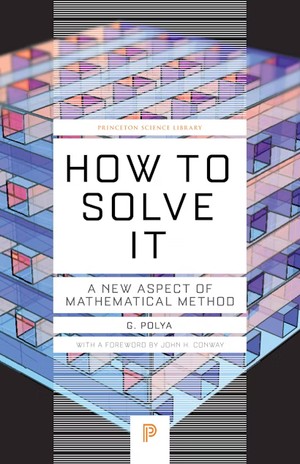Book Review: "How to Solve It" by G. Pólya

“How to Solve It: A New Aspect of Mathematical Method” is a classic work by Hungarian mathematician George Pólya, first published in 1945. The book is a guide to mathematical problem-solving and is written to develop strong problem-solving skills in the reader. It has influenced many areas, including computer science, programming, and artificial intelligence.
Even today Pólya’s book appears on many reading lists about software, maths and algorithms, although the writing style feels antiquated. “How to Solve It” is, for the most part, a dialogue between teacher and student. Pólya doesn’t just try to teach the reader how to solve problems, but also how to become a better teacher. He shows how to interact with students and what questions to ask, to make them solve problems and learn to solve them on their own.
The book revolves around the four steps of the problem-solving method.
The Pólya Method
1. Understanding the Problem
Understanding a problem is not as easy as it seems at first. Pólya’s approach is to ask the right questions. The problem needs to be divided into its parts — condition, data, and the unknown. Those can be divided further by asking if the condition is sufficient to determine the unknown or even contradictory.
At this stage, it often helps to draw a figure, write down the data, or restate the problem with other words. This leads to building a good understanding of the problem. The problem statement can often be abstract and it’s important to separate the meaningful and unnecessary parts of the data.
2. Coming Up With a Plan
After getting familiar with a problem, Pólya advises the reader to think deeply about it. He tries to think of anything that sparks ideas on how to solve it. Sometimes that involves a related problem or a way of working backwards from the solution.
At this point, the author recommends the use of heuristics. Those are different practical approaches to problem-solving that aren’t ideal or optimal, but effective. There are many heuristics described in the book. Some are specific to a certain kind of problem, others can be generally applied to almost any kind. The approach could involve solving auxiliary problems, using logic, trying to find a pattern or plain and simple guessing.
3. Executing the Plan
This stage of the four-step process is all about strictly following the plan developed in the previous step. Each step must be clearly understood and executed. This includes formally proving that the solution is correct.
4. Looking Back
Revising the work is a crucial and often overlooked step of the problem-solving process. Not only is it important to check if the solution is correct, but also to verify if the problem was solved completely and no part was missed. But Pólya urges the reader to do more than that. The solution should be reconsidered to see what could be done differently. Finally, this presents an opportunity to think about other problems that this solution could be used for.
The Classroom and the Method
Early in the book George Pólya explains his philosophy of the classroom, how to interact with the students and how to talk and motivate them. He gives many mathematical examples of how to guide the student through the whole process. This always starts with finding the unknown and concludes with looking back at the solution and trying to find a better or more interesting way of getting there.
The author cycles through different steps of the method, each time exploring different heuristics and examples. This is done by asking a lot of questions from the perspective of the teacher and then trying to act upon those questions from the perspective of the student.
A Short Dictionary of Heuristic
For the largest part of the book, Pólya writes about key points of heuristics. It’s written in the form of a dictionary. There is a lot of repetition and asking the same question already presented in the earlier parts.
Following the dictionary of heuristics is a set of problems, hints and solutions for the reader to exercise the four-step problem-solving process.
My Personal Thoughts
The book shows that Pólya was a man of both wisdom and intellect. His language is clear and concise. The wording of the book is dated, but easy enough to understand. The writing style takes a while to get comfortable with. It is mostly an imaginary discussion between the teacher and the student.
The simple dialogue style makes abstract processes easy to understand, and Pólya delivers a lot of knowledge while making sure it’s repeated often enough for everything to sink in. The problem-solving process described is not a mind-blowing revelation, though. Most of the approaches are well-known to anyone working in a technical job involving maths, but it can be beneficial to read about them from a different point of view.
Problem-solving is a vital skill for any software developer and it comes naturally with experience. “How to Solve It” is an interesting perspective, but not an essential read. It’s a good book to pick up for those interested in general mathematical problem-solving or the philosophy of teaching it.